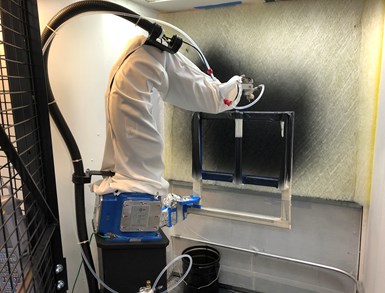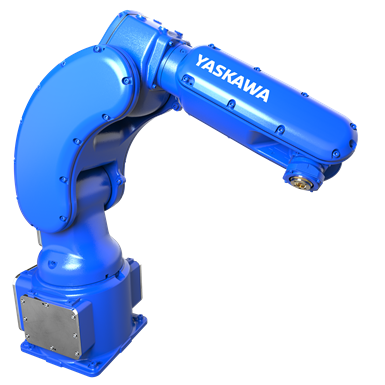
Robots specifically designed for painting and coating offer multiple benefits, optimizing product quality and production efficiency for greater ROI.
Photo Credit: All photos courtesy of Yaskawa America Inc.
Evolving consumer preferences continue to drive escalating demand for highly durable products with improved aesthetics. As a result, an uptick in usage of optimized industrial coatings is enhancing product performance and accommodating environmental standards. From aerospace and automotive to electronics, marine and more, multiple markets are seeing the value of high-performance paint and coating options.
To ensure each highly engineered mixture will perform to exacting standards, a growing number of manufacturers across various industries are implementing the use of robotic automation for paint performance testing. The process of spraying flat test panels (or coupons) by two-axis spray machines is giving way to coating curved surfaces (or speed shapes) via high-performance robots — as testing paint finish with speed shapes provides manufacturers a more realistic representation for analyzing certain paint or coating factors like durability and chemical resistance.
A Flexible Solution
Mindful of an aging two-axis spray machine used in their research and development (R&D) lab, one manufacturer recently sought a more flexible solution as a replacement. Internal research revealed that an optimized industrial robot with modern spray gun technology could provide the ability to consistently spray paint and other coatings uniformly onto both flat and curved test panels of various materials and sizes. As a result, company leaders collaborated with Yaskawa Motoman and successfully designed and implemented an effective robotic solution that 1) automatically loads paint to a spray gun, 2) guides the paint gun in set patterns, and 3) applies the paint across a desired substrate.

A riser-mounted MPX1150 robot that is Factory Mutual approved for Class 1, Division 1 use in hazardous environments enables precise, consistent coating for paint performance testing.
The Ideal Robot
Manufacturers looking to follow this lead and implement a more reliable solution should keep several concepts in mind when selecting the proper painting or coating robot. For confined areas with poor air circulation, a robot that is Factory Mutual (FM) approved for use in Class 1, Division 1 hazardous environments is advised. Requiring substantial electrical component protection to prevent fire or explosions, FM-approved robots help prevent flammable situations. This is especially true for robots where flammable vapors or particles could come into contact with exposed electrical components and motors. For this reason, painting and coating robots are specially designed with an air purge box that uses compressed air or an inert gas to manage the air purge cycle. Often referred to as “purged and pressurized”, this constant pressurization serves to evacuate the internal chamber of the robot arm from potentially harmful substances that could damage electronic equipment or create a volatile situation.
Other key robot features to consider include arm type, payload capacity, mounting configuration and work envelope. To provide ample placement for integrated cabling, pneumatic lines and paint hoses, a hollow wrist design should be selected. This will reduce entanglement with the robot arm or workpieces, as well as optimize robot reach for greater task flexibility. Adding to this versatility is a robot with an increased wrist payload, enabling a variety of spray guns and small bells to be used. To accommodate diverse demands, painting robots can often be mounted in various configurations. Significant improvements in the range of motion for wall-mounted robots is especially beneficial where greater flexibility is required. Improved arm designs (i.e., slim arm models) can also allow the painting or coating of workpieces closer to the robot for greater efficiency and increased robot density.

The slim-arm MPX1150 coating robot with a 5-kg payload wrist enables a variety of industrial coating tasks.
Multiple Robot Benefits
Whether implementing a paint performance workcell or another robotic solution, manufacturers that use painting and coating robots often see tangible results within the targeted payback period, accelerating return on investment (ROI). Operations considering the transition to high-performance robots should anticipate the following benefits:
- Greater Application Flexibility — Six-axis industrial robots provide manufacturers the ability to effectively adapt. Whether spraying paint or another coating, highly reliable robots can accommodate a wide variety of parts, including flat coupons and speed shapes of all sizes.
- Consistent Part Finishing — Extremely important to product quality, especially where high-gloss finishes are concerned, robots excel at consistency, causing few overspray issues. For example, a robot’s flexible range of motion is well-suited for paint performance testing, as it can coat all test panels uniformly within the desired spray window — another reason they are so helpful in R&D labs.
- Optimized Floorspace Utilization — Not only do versatile robots address a multitude of application needs, including the testing of a variety of unique shapes, but also, all equipment needed is usually contained in a relatively small footprint. For example, a paint performance testing workcell often includes a high-speed robot, paint gun bracket, intrinsically safe trigger valve, magnetic panel holder, hose containment device, pressure pot holder, a safety fence with a switch and an air panel. All of this can be installed in front of an open face booth or inside an enclosed workcell. Note: the robot being used should be able to go to a home position, while the panel holder should be able to pivot to a storage position, leaving the booth open for manual use, when needed.
- User-Friendly Programming — Designed for everyday users, such as paint lab chemists, robotic paint performance workcells can usually be controlled from an easy-to-use interface for efficient programming of the robot system. Newer models, such as MPX-series robots, feature an intuitive interface panel (I/F Panel) tab within the robot teach pendant and require no robot programming experience — as easily understood fields to specify parameters are given. Fields for items like panel size, tip speed, paint distance and spray overlap can be altered, allowing the robotic system to quickly write the robot job and execute the application. Savvy systems may also include a built-in timer for flash time for second-coat applications.
Along with these benefits, the use of robotic automation helps with higher application speed over two-axis spray machines, allowing for efficient labor organization and less dwell time. Similarly, due to robotic safety standards and robot safe-guarding, ongoing emphasis can be placed on workplace safety protocols, enhancing the overall work environment.
To experience the benefits robotic automation can provide in this type of work environment, manufacturers should reach out to a robot supplier or integrator that has a wide range of experience in dispensing and painting. This allows for efficient implementation, minimizing downtime while boosting ROI.
About the Author

Peter Goike
Peter Goike is associate chief application specialist at Yaskawa America, Inc. — Motoman Robotics Division. Visit motoman.com.
Related Content
Sames Inocart Systems for Manual Powder Coating
Sames Manual Powder Coating Solutions Providing TEC5 Technology for Optimal Finish Quality.
Read MoreAI Tool Optimizes, Automates Powder Coating
New “digital Blueprint” technology fine-tunes every aspect of a powder coating system. The platform promises at least 10% powder savings, a return on investment of a few days and an increase in uptime.
Read MoreUnlock Unparallelled Reliability
By prioritizing reliability in every aspect of its service offerings Dynapower ensures your equipment operates at peak performance levels consistently. With a steadfast focus on reliability, Dynapower’s field service, preventative maintenance and spare parts solutions ensure uninterrupted operations, minimizing scrap and maximizing uptime.
Read MoreFinishing Another Year — Looking Back at the Trends of 2023
Products Finishing reflects on a year of reporting on the surface finishing industry and looks ahead to what may be in store for 2024.
Read MoreRead Next
Racking and Conveyor Automation Solutions
Considerations for automating various operations within a finishing system.
Read MoreEpisode 12: Trends in Automation for Finishers
In this episode of On the Line, we hear insights into automation trends for finishers from Derek DeGeest of DeGeest Corp., Rob Weber of Fischer Technology, Jacob Fortmeyer of Carlisle Fluid Technologies and Robert Ravensburgen of OmniRobotic.
Read MoreWhen to Introduce Automation Into Your Finishing System
Looking to increase productivity for your liquid coating operation? John Owed of Carlisle Fluid Technologies provides examples of how automation can help improve quality and efficiency for paint spray equipment.
Read More






















